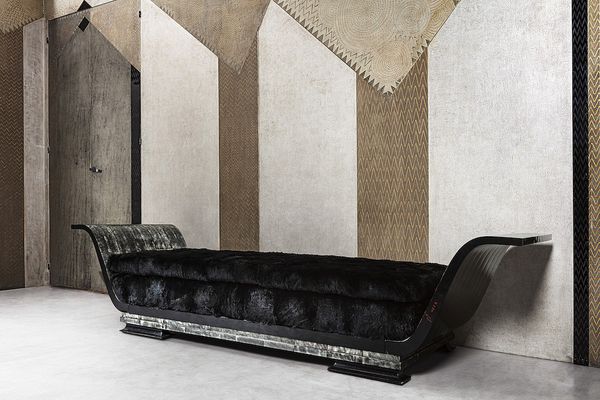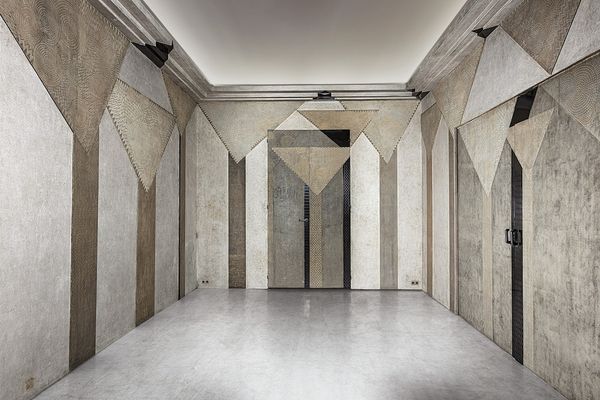Jean Dunand, Les Palmiers smoking room, from the residence of Mademoiselle Colette Aboucaya, Paris, 1930-1936.
Elie Massaoutis, Head of Design, France, takes us on a tour of Jean Dunand’s art deco masterpiece, Les Palmiers. Commissioned by Mademoiselle Colette Aboucaya, this elaborate smoking room is a time capsule containing the highest social and cultured interactions of Paris in the 1930s.

EM: Monsieur Gavelle, how did you become a specialist in boiseries and their assembly and disassembly?
PG: Originally, I was focused on 18th-century boiseries. I was fortunate enough to work at a company that worked on 18th-century paneling and the restoration of historical monuments. So this is my original apprenticeship. I never worked nor was trained in 20th-century or Art Deco panels.
EM: And what were the first boiseries that really attracted your interest? What have been the most important works that you have encountered?
PG: The King’s Bedchamber at Versailles, the Renaissance ceilings of the Louvre Colonnade, the Élysée Palace, Matignon and other very prestigious works...
EM: Mostly historical works. When you worked on these different projects, have you discovered hidden details that you were not expecting to find?
PG: Yes, and strangely, it’s not really related to the boiseries, but more to the people who have completed them—because we regularly find traces left from their authors, the carpenters, and the architects, sometimes we even find political graffiti from the period.
It’s almost like being part of a larger universal team working for the Art.
EM: In the historical works or in the 20th-century works?
PG: Always in the historical works, notably those at the Louvre. In the Napoleon III apartments displayed at the Louvre where Renaissance ceilings have been remounted, the Emperor is blasted in graffiti, which we discovered while restoring them. We also found addresses and names from the craftsmen who participated in re-installing the work. But this is a tradition of the Compagnons du Devoir. There is always the notion of transmission that is very closely linked to our apprenticeship.
EM: It’s something that you encounter somewhat regularly—it’s part of the historical process. And what do you feel when you install or de-install these precious interiors? Do you feel you are part of their history?
PG: It’s perhaps pretentious to say this, but to be the person who touched the boiseries Les Palmiers after Jean Dunand installed them and to know the paneling as well as he did, it is flattering! It’s almost like being part of a larger universal team working for the Art. And that’s intoxicating! Entering in Notre Dame, and touching the columns and thinking about the Compagnons who laid and chiselled the stones and received the same training I did; we pass and share our knowledge from generation to generation, since the beginning of time. For me, it has always been linked to my work, since the first time I used a wood chisel.
EM: Could you tell us a little more about your training?
PG: I completed an apprenticeship. After leaving school at 16, I joined the Compagnons du Devoir. I did my tour de France for five years, I studied cabinet-making. I presented my masterpiece and passed at age 21, and today, I teach my craft, I share my knowledge and my work.
EM: With Les Palmiers of Jean Dunand, what did you feel when you visited them for the first time?
PG: Ah, Jean Dunand! The Dunand boiseries are special to me…In my training, we considered cabinet-making in art to run until the 1930s. For us, the cubist period is already contemporary, and Jean Dunand is modern. We didn’t study that period as much, so we didn’t have formal training in this period. I knew about the painters of this period but I had to learn on my own. When I discovered Les Palmiers and their cubist style, I thought it was extraordinary. For me, it’s time travel. Even more so when I entered the apartment for the first time, after it had been entirely closed. It was a fifth dimension; it was like I had traveled to before the war.
For me, it’s time travel.
EM: When you say it was totally closed…?
PG: It was extraordinary. No one lived there. All the shutters had been closed many years ago. Newspapers dating from the 1960s were blocking the blinds, since the last time the flat was opened was to be photographed for an article published in Vogue in 1961. Nothing had been touched since. When we dismantled it, Ms. Aboucaya’s young nephew told us that apart from a party celebrating its unveiling, she never used that part of the apartment.
EM: What an extraordinary experience. It’s like walking into Tutankhamun’s tomb.
PG: Yes, it’s exactly like that. We had the impression of a discovery! It’s time travel. We leave our daily life. When I left, I had to catch my breath. I was totally stunned.
EM: What is unique about Dunand’s design? Was there anything that surprised you, something that was different than the 18th-century boiseries you more commonly work on?
PG: The construction had nothing to do with 18th-century boiseries. We have here an object constructed by a cabinetmaker, not by a carpenter, even if the two métiers are very similar. We are using the same assemblies, but one approaches the piece of wood totally differently. And it’s constructed like a cabinet, the grooves, tongues, and assemblies fit perfectly with each other. With traditional boiseries the construction is different. They are composed of primary and secondary elements, all of which are important to the design; the secondary elements support the primary ones, but they can be separated from one another. Here, the four sides form a whole. If there is only one side, it is wobbly, lopsided. You cannot remove any element to it.

Daybed in Les Palmiers smoking room, from the residence of Mademoiselle Colette Aboucaya, Paris, 1930-1936.
EM: In fact, the conception of the structure demands a great deal of freedom.
PG: Yes and no, when they constructed Les Palmiers, they were unlimited by dimensions—which is to say, one could make panels that could be kilometers long. The construction process is one of freedom; it is limited only by the quality of the material. Here, like any renowned artist of the time, the cabinet-makers created their own supports. Small brackets were placed next to each other, then they were fastened with plywood (2-3mm thickness). And then the veneer was added (20mm thickness). There’s even another way—the brackets, instead of being brackets, are made from plywood, bonded together. The wood cannot move because small pieces, bonded to each other, were used. It’s extremely avant-garde. You can see a modern gymnasium with laminated wood forming the beams—it’s exactly the same principle on a smaller scale, and as a consequence, the supports are very stable and of an extraordinary quality.
EM: That explains why the boiseries are in such a pristine condition today.
PG: And there isn’t a single crack. Because each time we changed the room’s location, we knew there were small pieces of wood that fit with each other. So, the wood never moves, nor do the great mouldings. One can see that they are perfectly set. The doors have not moved despite the fact that they are in their original position—and they are functional. Even if one took out the supports, the doors would stay stable, but if one tried this with today’s materials, they would immediately become flimsy. The quality here is in the construction, but also in the materials that were used and its representation.
EM: It was like that from its conception. We can think of it really as a masterpiece in which Jean Dunand and his team put the best into everything.
PG: Not only that, but it was conceived to last. When it was made, Dunand could have used other supports and materials. And even in thinking about how the apartment was updated and sold, it could have been cleared away, as sometimes happens. But it wasn’t the case, fortunately. It was conceived to last and has lasted.
As far as I’m concerned, I always look at the room with joy.
EM: Extraordinary! And you have had these boiseries pass through your hands a few times now, first in 1997, then in 2001, 2002 and even at the Palais de Tokyo in 2011 when they were last sold.
PG: Yes, when they were re-installed in 2011, I had the joy of rediscovering them. It was a bit like seeing a lover that I never really left, to whom I was always loyal. As far as I’m concerned, I always look at the room with joy.
EM: It’s a story of a lasting love.
PG: Yes, absolutely. I have kept archives from the first time I encountered these boiseries, I have all the plans. I even kept some exchanges with the owner, with different owners, pictures of the building site. The auction house who then sold it to the castle kept images to make greeting cards, and I kept the card with the images of the boiseries in a file, just to have in my archives. I have all the catalogues, books, everything that is related to them. It has become almost an obsession.
EM: It is becoming that way. You are happy to come and install it one more time for us, to have it constructed for the last time.
PG: Yes, I would like to put the room in a place where it can stay the rest of its life, because it will start to suffer from all these installations and de-installations. Because even if it is of great quality and doesn’t show wear and tear, it is still fragile.
EM : To conclude our interview you mentioned to me earlier a story you tell your students that one of your teachers told you many years ago?
PG: Yes indeed, when I was a young apprentice, in order to make me understand the importance of the application of my work, one of my teachers told me an anecdote of a man walking by a cathedral construction site. He asks the first worker with a cold chisel that he meets “What are you doing?” The worker responds “I am carving a stone.” He continues and asks the same question to the second worker he sees who responds to him “I am participating in the elevation of a wall” and up to the third one who responds to him “I am participating in the elaboration of a work of art.” It is this mindset that drives us: to participate in the complete realization of a work of art, not only a simple task! It is with that goal that the workers, the Compagnons, surpass and deliver the best of themselves: for the realization of a masterpiece like Les Palmiers.
Contact
Elie Massaoutis
Head of Design, France and Senior International Specialist
emassaoutis@phillips.com
+33 786 34 53 15

Recommended Reading
In Conversation with Collector Enea Righi >
How Genieve Figgis Inspired ‘Bridgerton’ >
